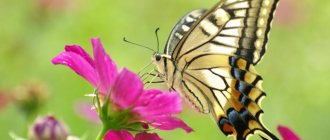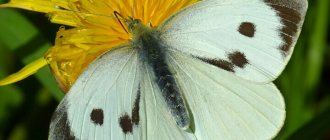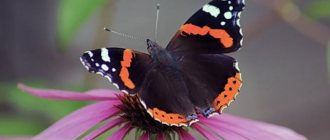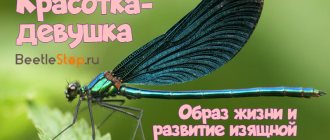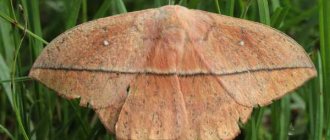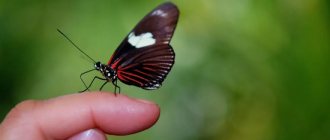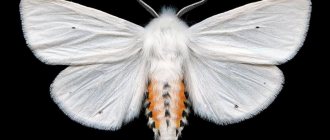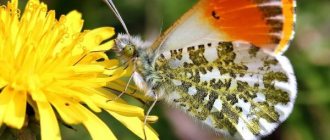The white butterfly family combines daytime butterflies with light-colored wings. There are about 150 species of them in the Palearctic. Among the first insects of spring, the lemongrass butterfly stands out with its bright sunny color. It can be seen in forest clearings, meadows and parks. Some species of white butterflies are named after their food plants, so the second name of the butterfly is buckthorn.
Origin of the species and description
Photo: Lemongrass butterfly
Lemongrass belongs to the whiteweed family (Pieridae). It also contains pests such as cabbage grass and turnips, but lemongrass themselves are not considered pests, since their caterpillars feed mainly on buckthorn. That’s why they have another name – wreckers. Whitefish belong to the order Lepidoptera. As evidenced by the findings of paleoantologists, the first representatives of the order inhabited the planet at the beginning of the Jurassic period - the age of the oldest remains found is approximately 190 million years.
Video: Butterfly lemongrass
By the Cretaceous period, when flowering plants were increasingly spreading across the planet, Lepidoptera also flourished. They acquired a well-developed mouthparts, and their wings also developed more strongly. At the same time, the formation of a long proboscis occurred, intended for sucking nectar. The number of lepidopteran species became more and more numerous, larger ones appeared, the length of their life in the form of adults increased - they reached a real heyday. Although in our time the diversity of this order is also amazing, it contains many dissimilar species.
Interesting fact: Butterflies change four forms during their life: first an egg, then a larva, a pupa and, finally, an adult butterfly with wings. All these forms are strikingly different from each other, and imago is the name of the latter.
Lepidoptera rapidly evolved along with flowering plants. By the Paleogene, most of the modern families, including whitefish, were finally formed. The appearance of modern lemongrass dates back to the same time. Gradually, new species of them continued to appear, and this process is still not completed.
The genus Schisandra includes from 10 to 14 species; researchers have not yet reached a consensus on the exact classification of some. The difference between species is mainly expressed in size and color intensity. Further, in all cases, unless otherwise indicated, we will be talking about lemongrass, described by Carl Linnaeus in the fundamental work “System of Nature,” which appeared in 1758.
There are several more well-known and common types:
- Cleopatra, living in the Mediterranean;
- Aminta, the largest - its wingspan reaches 80 mm, is found in Southeast Asia;
- aspasia - Far Eastern butterflies, on the contrary, small (30 mm) and very brightly colored.
Nutrition
Most often, the cabbage butterfly is photographed sitting on a cabbage. The name of the insect also speaks of its love for this vegetable. However, cabbage is not the only delicacy of the cabbage whites. The adult cabbage butterfly feeds on flower nectar, preferring dandelions, daisies, alfalfa, and greenweed.
But her offspring are very fond of leaves of cabbage, rutabaga, horseradish, turnips, rapeseed, radishes and radishes. The cabbage caterpillar will not refuse capers, nasturtium, mustard and even garlic. The gluttony of caterpillars (they eat almost continuously) makes them dangerous pests of fields and vegetable gardens.
Appearance and features
Photo: Yellow butterfly lemongrass
In its form, the imago has elongated front wings and rounded hind wings - both have a pointed end. The hind wings are slightly longer and can reach 35 mm. The color allows lemongrass to camouflage well: if they fold their wings while sitting on a tree or bush, it is difficult for predators to notice them from afar.
Females and males differ primarily in the color of their wings: in males they are bright yellow, which is where the name of these butterflies comes from, and in females they are white with a green tint. There is a small orange spot in the middle of the wings.
They have faceted eyes and a round head, as well as a very long proboscis, with the help of which they can extract nectar even from very complex flowers. There are three pairs of walking legs; with their help, lemongrass moves along the surface of the plant. There are four pairs of wings.
Sizes vary greatly depending on the species, with a wingspan typically around 55mm. In representatives of the largest species it can reach 80 mm, and in small lemongrass it is only 30 mm. The caterpillars do not stand out externally: they are green to match the foliage, they are covered with small black dots.
Interesting fact: If it is not very hot, then as soon as the sun disappears behind the clouds, the lemongrass tends to land on the nearest flower or tree - it is very difficult for it to fly without direct sunlight, since a high temperature must be maintained for flight.
Habitat
An insect similar to a hummingbird is capable of flying over long distances. Over the course of one year, up to two generations of hawk moths manage to develop. The first flies from the first days of May to mid-July. For the most part it consists of individuals arriving from the south. The second generation flies from August to October. At the same time, some butterflies migrate to warm regions in the fall.
An insect similar to a hummingbird can be found in almost any country with a warm and temperate climate. For example, in Crimea, hawk moths are found everywhere and produce at least three generations during the year. Both the butterfly and the pupa overwinter. Moreover, if there is a prolonged thaw in winter, they can make an unscheduled flight, therefore, they can be seen in any winter month.
They prefer open, well-warmed areas as permanent habitats. In cities, it can be seen in flower beds, hovering over flowering plants. In wild conditions, the hawk moth prefers to feed on the nectar of cornflowers and blueberries, and in cultivated landscapes - geraniums and petunias.
The world of insects is vast and amazing. A special place in it is occupied by lepidoptera, or butterflies, the diversity of which amazes everyone: the layman, the amateur, and even the researcher. Thus, among the well-known marigolds and cabbages, there are truly exotic representatives of the class. The hawk moth butterfly is similar. The family has such unofficial names as “sphinx” or “northern hummingbird”. The origin of the first is associated with the unusual way the moth eats food, the second - with the heroic size of usually fragile and graceful insects.
Entomologists have identified a huge number of species of hawk moth butterflies, each of which has a distinctive color and a distinctive wing pattern. You can verify this by looking at specific examples. Thus, the wine hawk moth has exquisite burgundy wings; The death's head hawk moth stands out among others due to the unique pattern on its wings and back, reminiscent of a symbolic image of a human skull.
What is the reason for such a wide range of color varieties of species of one family? Scientists attribute this fact to the dependence of color changes on the animal’s diet and habitat. However, despite such a wide palette, most hawkmoth butterflies are decorated with a pattern, the compositional elements of which are an oblique stripe and large “eye” spots.
Where does the lemongrass butterfly live?
Photo: Krushinnitsa
The habitat is very wide, it includes:
- most of Europe;
- Near East;
- Far East;
- North Africa;
- Southeast Asia;
- Canary Islands;
- Madeira Island.
These butterflies are not found in the deserts, steppes of the Ciscaucasia, beyond the Arctic Circle, and they are also not found on the island of Crete. They are very widespread in Russia; they can be found from Kaliningrad to Vladivostok. They are capable of living in harsh natural conditions, almost to the Arctic Circle.
First of all, their habitat is determined by the distribution of buckthorn as the main source of food for the caterpillars, although they are also capable of eating other plants. While the common lemongrass is widespread, other species can live in a very limited area; there are several endemics living in the Canary Islands and Madeira.
It is curious that these butterflies do not live in fields, preferring thickets of bushes, various gardens, parks, edges and woodlands - the main areas where they can be found, since lemongrass also does not settle in dense forests. They also live in the mountains, but not too high - they are no longer above 2,500 meters above sea level. If necessary, they can fly long distances to find the most convenient area for habitation.
Now you know where the yellow, bright butterfly lives. Let's now see what the lemongrass butterfly eats?
Defense strategy
All types of butterflies and moths begin life as a caterpillar. This is a very vulnerable form of the insect and therefore needs protection.
Their appearance varies greatly, especially with regard to coloration, which plays a major role in their ability to protect themselves from predators. In many cases, their coloration is meant to mimic the appearance of their surroundings, and this changes as they grow. For example, the young larvae of many swallowtail butterflies (Papilio) are white and brown, resembling bird droppings on the leaves, but over time their appearance changes such that the colors eventually become camouflage, allowing them to blend into the leaves and stems of plants . In some caterpillars, coloration is noticeable or enhanced by the presence of features such as false organs of vision, which can deceive or frighten predators.
Other defense strategies used by caterpillars include secreting foul-smelling substances, using sounds, generating vibration signals, and sequestering chemicals into tissues that are toxic to predators. Caterpillars of the great night peacock eye (Saturnia pyri) send out ultrasonic warning signals to deter predators. The caterpillar of the sicklewing butterfly (Drepana arcuata) produces vibration signals to defend its territory from intruders of the same species; she knocks her jaws on the surface of the leaf and scratches it with her hair-covered feet.
Monarch butterfly (Danaus plexippus) larvae rely on a defense system associated with their unique ability to feed on milkweed (Asclepias) plants. These plants produce compounds known as cardenolides, which are typically toxic to animals. Monarch butterfly larvae are not affected by the poison, and they are able to sequester the compound in their tissues. Since the poison remains in insects during subsequent stages of development, they are toxic to vertebrate predators, both as larvae and as adult butterflies.
What does the lemongrass butterfly eat?
Photo: Lemongrass butterfly in spring
In the form of an imago - nectar.
Among the plants whose nectar attracts lemongrass:
- primroses;
- cornflowers;
- sivets;
- thistle;
- dandelion;
- thistle;
- coltsfoot;
- liverwort.
Wildflowers predominate among preferences, although garden lemongrass also drinks the nectar. Thanks to their long proboscis, they can even feed on nectar that is inaccessible to almost all other butterflies - for example, the same primrose. For many spring plants, it is vital that they are pollinated by lemongrass, because there are almost no other butterflies at this time. The larva feeds on buckthorns, like laxative buckthorn, zoster and others.
They eat the leaf from the middle to the edge in a few days, growing quickly, and by the time they get to the outside of the leaf, molting is already over. They do not cause much harm to buckthorn, and are almost harmless to cultivated plants, with a few exceptions: caterpillars can feed on the foliage of plants such as cabbage, rutabaga, turnips, horseradish, radish or turnips. But cases when they harm plantings are very rare, since lemongrass eggs are usually laid in thickets and on forest edges.
Interesting fact: Lemongrass chooses which flower to sit on not by the smell they emit, but by color. These butterflies are most attracted to blue and red flowers.
Lifestyle
The first year of the butterfly occurs in March. From this moment, adults are active until June. Then comes diapause, during which lemongrass stops all functional processes in the body. The second year falls in August - and these are butterflies of a new generation.
Lemongrass are diurnal, and the warmer the air, the more active they are. Having frozen on the branches of trees, adult individuals spread their wings, exposing them to the rays of the sun. Looking at this, we can say about the lemongrass butterfly that it is “fuelled” by ultraviolet light.
Towards evening, insects try to hide in thickets of foliage so that we can wait out the night. Most often, lemongrass can be found in ivy branches.
Features of character and lifestyle
Photo: Lemongrass butterfly
They are active during the day and fly only when it is sunny. They love warm weather very much, and in the spring, if it’s cool, they often freeze for a long time, folding their wings at a right angle and trying to catch as many sun rays as possible - first one side is exposed to them, and then the other. As soon as evening comes and it becomes less light, they begin to look for a convenient place to spend the night - usually thickets of bushes are used for this. They land on a branch deep in the thickets and, folding their wings, become almost indistinguishable from the surrounding greenery.
Unlike most other butterflies, which do not spend much time in flight due to the large expenditure of energy on it, lemongrass is very hardy and can fly for most of the day, covering long distances. At the same time, they are able to rise to great heights. Since they live a long time by the standards of butterflies, they need to conserve their vitality - therefore, if conditions become less favorable, for example, rainy weather sets in and it gets colder, then even in the middle of summer they can begin diapause. When it gets warm again, lemongrass wakes up.
Interesting fact: Diapause is a period when the butterfly's metabolism becomes much slower, it stops moving and becomes much more resistant to external influences.
Lemongrass is one of the first to appear - in warm regions starting in March. But these are butterflies living for the second year; they lay eggs in the spring, after which they die. Young individuals appear in early summer, and in mid-autumn they go to spend the winter to “thaw out” in the spring. That is, the life expectancy of lemongrass in the form of an adult is about nine months - for daytime butterflies this is quite a long time, and in Europe they even hold the record for longevity.
For the winter they hide deeper in the thickets. They are not afraid of frosts: the increased retention of glycerol and polypeptides allows them to remain alive in hibernation even at an air temperature of –40 °C, especially since the shelter, especially if it is under snow, is usually much warmer. On the contrary, thaws are dangerous for them: if they wake up, they spend a lot of energy flying, and since there are no flowers yet, they cannot renew their supply. When there is a sharp cold snap, they simply do not have time to find a new shelter and hibernate again - and die.
Interesting Facts
- This butterfly lives longer than other species.
- During rest he can sit still.
- After mating, they can remain stuck to each other for more than 24 hours.
- They often sit on yellow and reddish-purple flowers in order to hide themselves as much as possible from annoying eyes.
- Translated into Latin, the word “Krushinnitsa” means “lat. Brimstone" is what the sun stone "Amber" was called in the old days.
- It actually overwinters outside shelter on the ground or on fallen leaves.
Video
Social structure and reproduction
Photo: Butterfly wreck
They live alone, and only fly in pairs during the mating season. It falls in the spring, and the initiative belongs to the males, who perform a simple mating ritual: when they meet a suitable female, they fly after her for some time at a short distance. Then the male and female descend onto the bush and mate.
After this, the female looks for a place near the buckthorn shoots so that the larvae have enough food, and lays eggs, one or two on each leaf, up to a hundred in total. They are held in place by a sticky secretion. It takes a week or two for the eggs to mature, and by the beginning of summer the larva appears. After its appearance, it begins to absorb the leaf - in the form of a caterpillar, lemongrass is very voracious and eats almost all the time, growing from 1.5 to 35 mm. The time it takes to grow depends on the weather - the warmer and drier it is, the faster the caterpillar will reach the desired size and go through all the molts. This usually takes 3-5 weeks.
Then she pupates. The time spent in the form of a pupa depends on the climate and is 10-20 days - the warmer it is, the faster the butterfly will appear. Having got out of the cocoon, it spends a little time just hovering to spread its wings and let them get stronger, and then it can fly freely - the individual immediately appears as an adult and fully adapted to life. In total, all stages of development take from 40 to 60 days, and an adult butterfly lives another 270 days, although it spends a significant part of this time in hibernation.
Life cycle
The pupae spend the winter attached to host plants or in a nearby garden. The butterflies emerge in the spring and migrate north to areas too cold for winter survival.
White butterflies feed on nectar and lay pale green domed eggs on the underside of plants of the Brassic family. To lay the butterfly, they use the tip of their belly and distribute the eggs into batches.
The eggs hatch in 3 – 7 days. The destructive larval stage reaches full development in 2-4 weeks, feeding voraciously on cabbage, storing up energy for transformation into a pupa and winter metamorphosis. They live in a group for some time. They cause great damage to the host plant by eating and destroying it.
They pupate in thin silken cocoons attached to stems or the undersides of leaves. Adults emerge after 10 days.
Two generations of cabbage butterflies are produced each year. The first brood consists of adults with spring hatching around April. The second, from the adults that are born in July. Sometimes the third brood is observed in late summer if the weather is warm.
Behavior, migration
Butterflies fly starting in early spring and migrate until autumn. This means there are usually two to three flights per breeding season.
In spring they fly in random directions, excluding the north, and return migration is not observed. Whitefish can fly 800 kilometers.
Natural enemies of lemongrass butterflies
Photo: Lemongrass butterfly
There are many of them: danger threatens lemongrass at any stage of development, because there are people who like to feast on them in any form. It’s easiest for adult butterflies, since predators still need to catch them; there are no such problems with other forms.
Among the enemies of lemongrass:
- birds;
- spiders;
- beetles;
- ants;
- wasps;
- many other insects.
There are more than enough predators that feed on butterflies, but their most terrible enemies are birds. They most often eat caterpillars, because they are nutritious prey that do not need to be hunted. In total, birds destroy on average about a quarter of the caterpillars. Some birds also attack adults - most often lying in wait for them when they are resting or drinking nectar.
The easiest way for them is to hit the prey with its beak when it sits down and kill it, then separate the wings from it and eat the body. Although some are dexterous enough to grab butterflies on the fly, for example, swallows do just that. But for imagoes, birds and predators in general are not so dangerous - they can fly away, and their protective color helps, making them difficult to notice when they are resting. It is much more difficult for caterpillars: they are hunted by a much larger number of predators, including small ones that are too tough for adult butterflies - and they are not able to fly away or escape. In addition, although the caterpillars also have a protective color, their eaten leaves give them away.
Ants love caterpillars, killing them with the help of coordinated actions of large groups and then dragging them to their anthills. Parasitic wasps can lay eggs directly into living caterpillars. The larvae emerging from them then devour the caterpillar alive for a long time. Sometimes because of this, she dies before she has time to become a pupa, but even when she manages to survive until this happens, parasites, and not a butterfly at all, emerge from the pupa. In addition, butterflies are also susceptible to bacteria, viruses and fungi, and they can be parasitized by small mites.
Useful video
In this video you will learn how to protect your crops from butterflies:
See inaccuracies, incomplete or incorrect information? Do you know how to make an article better?
Would you like to suggest photos on the topic for publication?
Watching the fluttering bright moths, so airy and beautiful, you can’t help but wonder: how long do butterflies live? We would like such an unearthly miracle to be with us for a long, long time, illuminating our lives with the trembling of its wings, colored with all the colors of the rainbow. But, alas, the life of these creatures is sadly short, especially if we consider the butterfly to be the last stage of a moth's life - in fact, its maturity and old age.
Moths are influenced by their species. After all, we are talking about a sensation that loses its relevance the next day - a “one-day butterfly.” However, the minimum period allotted by nature for beauties with fluttering wings is still not a day, but 3-4 days. This is a type of butterfly called blueberry. Compared to them, the Monarch Danaid is a real long-liver - it lives in the winged creature stage from nine months to a year. Well, an ordinary resident of our latitudes, who in her “childhood”, like a caterpillar, caused so much damage to vegetable gardens - the cabbage fly flutters around for about two weeks.
If we solve the question of how long a butterfly lives globally, that is, we begin to take into account all stages of its life cycle, then we will get a very diverse picture. For example, Vanessa spends 3-4 days in an egg, from five to ten days in the caterpillar stage (depending on how much she eats and accumulates fat to transform into a moth), sleeps in a pupa from a week to ten days, and turns into light-winged sissy for only two weeks. In this short period of time, Vanessa must find a representative of the opposite sex, mate with him, form eggs in her body, lay them and die. Maybe this is why female moths live several days longer than males - in order to have time to lay eggs?
The habitat especially plays an important role in how long butterflies live. However, despite the fact that moths, as we know, love warmth and light, their presence is directly proportional to the degree of geographic latitude. Species living in arctic and subarctic latitudes can generally live up to two years, since poor food and a short time do not allow the larva to accumulate enough useful substances to turn into a winged insect, and an adult does not emerge from the pupa the following spring. The prolonged “youth” allows the caterpillar to live another, additional year.
Migration flights, if any, also influence how long butterflies live. If insects make two migrations per year, then two generations change over the summer: chrysalids (pupae) open in the spring and at the end of summer. Wintering butterflies spend the longest period of their lives precisely in the pupal stage: caterpillars envelop themselves in a cocoon at the beginning of autumn, and leave the unnecessary shell with the onset of stable warmth. There are species that manage to overwinter in the caterpillar stage, for example, the crimson silkworm, but this is more of an incident than a generally accepted rule. Usually silkworms spin a warm cocoon for themselves and are bred by people to obtain natural silk.
But vanessa thistle, day thistle and lemongrass can overwinter in the adult stage. Of course, how long butterflies live is influenced by the severity of winter and the place they choose for wintering. Severe cold can kill a gentle creature, and winter thaws or the warmth of human homes can bring the moth out of the stage of suspended animation and it dies from exhaustion. If you want to prolong the life of such a beauty, you need to create conditions for her that are as close as possible to those that she experiences as an adult: sufficient lighting, warmth (for tropical species, at least + 28), nectar-bearing plants. Then, despite her short life, she will leave you as a consolation her descendants, who, generation after generation, will delight you with their rainbow fluttering.
Urticaria - a connoisseur of birch sap
Aglais urticae, wingspan – up to 50 mm
You've probably seen this butterfly more than once, but you couldn't even imagine that the offspring of this luxurious beauty feed on stinging nettles! A special sign of urticaria is large black spots on dark orange wings. The hind wings are covered with small blue spots. The insect feeds on nectar of various flowers, and also does not refuse birch sap.
nasekomus.ru
One clutch of wren can contain up to 150 eggs, from which black, hairy caterpillars emerge. They gradually begin to eat the nettles, and at its top they build a nest of cobwebs for shelter from bad weather. After numerous molts, the caterpillar becomes yellow-black and is ready to pupate.
How to attract hives. The answer is obvious - plant nettles! But if you don’t want to see this weed in your summer cottage, try pouring a little birch sap into flat containers to attract insects. And plant lavender, oregano, echinacea, David's buddleia, spirea, bird cherry and other aromatic plants in your flower beds.
- What to plant in a flower garden to fill the garden with an unforgettable aroma
Do you want to plant fragrant flowers on your property? Then take a look at our selection!
Cabbage is a dangerous pest of cabbage heads
Pieris brassicae, wingspan – 45-63 mm
Cabbage grass, or cabbage white, is familiar to every summer resident. You can find it in beds with cabbage, turnips, turnips and other cruciferous crops. The butterfly is fussily looking for a place to lay eggs, from which yellow-green caterpillars will soon appear. During the season, one individual lays up to 300 eggs!
Unprepossessing in appearance, the white hare terrifies with its appearance. You should especially be wary of females, the main difference of which is the black spots on the upper wings.
The voracious caterpillars of the white butterfly eat the leaves and prevent the head of cabbage from forming. After a while, only the veins remain from the leaf. When the food runs out, the pests crawl to new plantings.
How to deal with cabbage and its caterpillars. Safe methods include hand-picking caterpillars and catching butterflies. You can also plant marigolds, marigolds, mint or sage between the rows, which will repel pests. A good way is to cover the cabbage with a mosquito net and agro-canvas so that butterflies cannot lay eggs. Folk remedies will help by spraying 2 tbsp. mustard and 1 tsp. ground red pepper per 10 liters of water. And if there are a lot of insects, use Fitoverm, Karbofos, Actellik or another insecticide.

